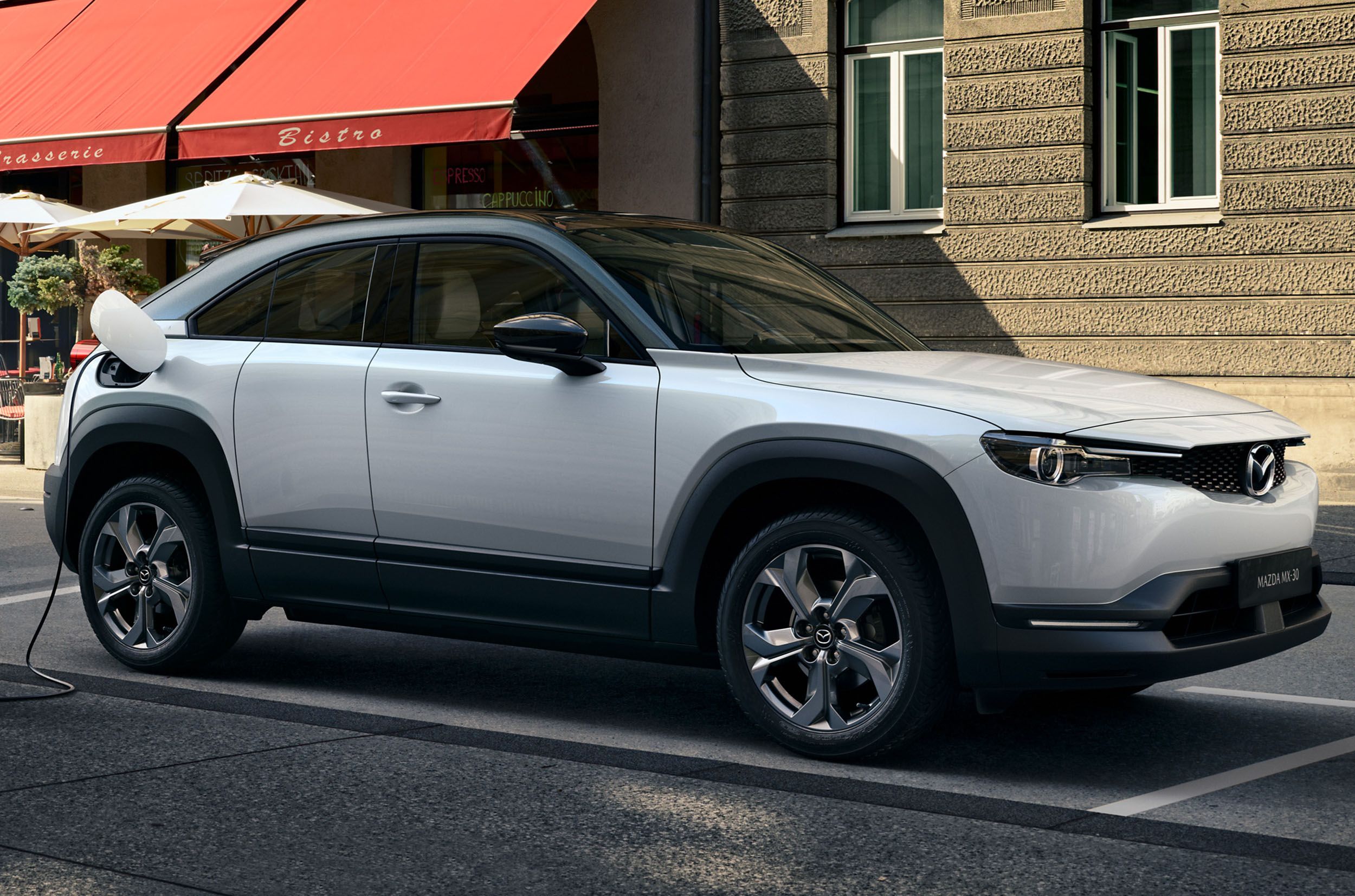Mazda could have played it safe with this one but it didn't. Instead, it went bold. Rugged, in fact. All the more impressive is the fact that the all-new 2021 Mazda MX-30 is the Japanese automaker's first-ever all-electric vehicle. Going bold is something GM, for example, never would have done. Just look at the Chevrolet Bolt.
The new MX-30, by contrast, has unique styling inside and out that may not be to everyone's liking. Mazda has been repositioning itself over the past few years as a more premium brand overall, and the MX-30's slightly more rugged look is not what everyone expected. But it also serves as the ideal gateway model for the brand as it takes its first step towards all-out electrification. The question is whether the MX-30 can successfully challenge the likes of the popular Hyundai Kona Electric, Kia Niro EV, and even the upcoming BMW iX3.
Unique Styling And Suicide Doors
The Mazda MX-30 is built on the same platform as the also new Mazda CX-30. However, that's where a majority of the similarities end. The MX-30, which borrows its moniker from the MX-5 Miata, features squared-off wheel arches clad in contrasting trim that extends around the bottom of the vehicle. The black roof also contrasts with the rest of the bodywork. Metallic-painted pillars further augment this. The overall design is more upright than we expected, intended to look as if the vehicle was chiseled from a solid block of billet. The general look is still very much modern Mazda, but it's clear the designers were given the order to do things to further set the MX-30 apart from the rest of the pack.
Perhaps the boldest and most noticeable design choice is the "freestyle" doors, sometimes referred to as suicide doors. This isn't the first time Mazda has used these. Remember the dearly departed RX-8 rotary sports car? This design decision also eliminates the traditional B-pillar that normally separates the front and rear passenger compartments.
More Bold Choices Inside
Mazda didn't stop with the interesting design decisions on the outside; the interior is equally unique compared to the rest of the brand's lineup. For starters, instead of the typical plastic trim and leather upholstery, there's renewably sourced cork trim and fibrous textile upholstery made from recycled plastic bottles. If you're going to build and sell an environmentally friendly EV, it makes sense to use alternative build materials.
Take notice of the horizontal layout of the dashboard, which features a center console complete with a 7-inch touchscreen display. There are plenty of power outlets to recharge smartphones and tablets, too. Mazda claims there's enough luggage space to accommodate four carry-on suitcases. Those "freestyle" doors also provide a more open-air cabin with easy access for both front and up to three rear-seat passengers, though three adults in the back might be a bit of a squeeze.
Zoom-Zoom Goes Electric
For years, Mazda's tagline has been "Zoom-Zoom," implying its dedication to performance and driving fun. And there's no reason why this same tagline can't be applied to an EV. The vehicle's architecture, as previously noted, was also designed to accommodate a pure battery-electric powertrain. The MX-30 has a 35.5-kWh lithium-ion battery that provides a total driving range of about 130 miles on a single charge on the European testing scale. Charging an empty battery to 80 percent takes 36 minutes using a DC fast charger.
In the US, Mazda rates this drivetrain at 144 horsepower and 200 lb-ft of torque. The MX-30 also features a G-Vectoring Control active chassis which, according to the automaker, "leverages the torque characteristics of the electric motor to optimize the front-rear load shift under an even wider range of usage scenarios." The 2022 MX-30 will be a pure electric vehicle but the 2023 model will add a Wankel rotary engine under the hood to extend the driving range.
Pricing And Competition
Official pricing has not been announced though Mazda has plenty of time to decide on this. The Mazda MX-30 is due to go on sale in the US in fall 2021, but only in California. The range extender model will arrive in 2022. More than likely, it'll be priced very competitively against the likes of the Hyundai Kona Electric, which begins at $36,950, though there are certain to be some federal and state tax rebates available to help lower the final price.
Aside from the Hyundai Kona EV, the Mazda MX-30 will face off against the Kia Niro EV and the upcoming Volvo XC40 Recharge. All three are classified as compact all-electric crossovers. The also upcoming BMW iX3 is another potential competitor, though we expect it will have a higher starting price.
One specific area that may hinder the new MX-30 is range. As stated above, it currently offers just 130 miles of driving on a single charge. The Kia Niro EV, by contrast, can do 239 miles. In other words, that Wankel rotary engine range extender will probably be needed sooner rather than later.

